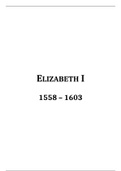ELIZABETH I
1558 – 1603
,BACKGROUND OF ELIZABETH I
Elizabeth I’s Character
She was very well educated, and had been brought up with all the training of a potential heir.
She was cultured in the arts, music, literature and languages.
She learnt much from her personal and political experiences, including her tempestuous relationship
with Thomas Seymour, and the accusation of her being implicated in Wyatt’s Rebellion.
Accession of Elizabeth I
Elizabeth ascended to the throne at the age of 25.
On the day that Queen Mary died, in November 1558, Sir William Cecil informed Elizabeth of her death.
Mary’s councillors were aware that Elizabeth did not share their political views, and many guessed that
their political careers were over.
However, they made no attempt to interfere with the lawful succession.
Mary had recognised Elizabeth as her successor before her death.
However, in some respects, it was a difficult succession.
This was because England had suffered from a series of bad harvests, so food was expensive, and the
country had also suffered from the influenza epidemic.
The political and religious situation was also delicate.
Furthermore, England had fought a disastrous war with France, which resulted in the loss of Calais.
There was also the question of finding a suitable person for Elizabeth to marry, in order to produce an
heir to guarantee the succession.
Elizabeth I’s Aims
She was determined to preserve the prerogative powers of the Crown, which meant that she insisted on
taking the most important decisions.
She wanted to consolidate her position.
She also wanted to settle religious issues.
Furthermore, she wanted to pursue a peaceful settlement with France.
Elizabeth I’s Consolidation of Power
Her path to power was eased by the acceptance of her succession by Mary’s key councillors.
Within a few days, nine of Mary’s councillors had assured Elizabeth of their loyalty.
Therefore, there would be no attempt to deny Elizabeth’s succession by devout Catholics who had never
accepted the validity of Henry VIII’s marriage to Anne Boleyn.
Cecil was appointed principal secretary, a post which he held until his death in 1598. Elizabeth also made
some other household appointments.
Cecil was also given the title of Lord Burghley in 1571.
She also showed herself to be familiar with customs related to the ascension of new monarchs.
Her coronation also took place quickly, in January 1559.
Furthermore, she gained a measure of international confirmation through the proposed marriage
between Philip II of Spain, which came to nothing.
However, it did show that Philip was unwilling to disrupt the smoothness of her ascension.
, GOVERNMENT UNDER ELIZABETH I
The Royal Court
The royal court was important to the Elizabethan decision-making process.
Here, Elizabeth could seek advice on an individual basis.
It existed wherever the Queen happened to be at a particular time, and had two main areas – the
Presence Chamber and the Privy Chamber.
The Presence Chamber was a relatively open area, which anyone with the right status or connections
could access.
The Privy Chamber was more private and more important, although it was considerably less influential
than during the reigns of the Tudor Kings.
This is because the Gentlemen of the Privy Chamber no longer had the rights of access to the monarch,
which they had formerly enjoyed.
The operation of the court came under the judiciary of the Lord Chamberlain.
Elizabeth always appointed a member of the nobility to this post.
The System of Patronage
Elizabeth had a strong appreciation for the need to gain and retain the loyalty of politically important
members of Tudor society.
This was achieved through patronage, which was central to the operation of the court.
Elizabeth bestowed these favours carefully, and to a wide circle, so that goodwill was maintained.
Elizabeth’s aim was to ensure that as many nobles and gentry were bound through patronage in loyalty
to the Crown.
This would mean that there would be relatively few who would lend support to plots against her.
This proved to be important, especially during the 1595 Rebellion of the Northern Earls.
This reflected the advice that she was given by Cecil, her chief secretary.
The most valuable patronage was the grant of office, varying from high positions in society to low
positions such as household servants.
Those who acquired office often found that their office gave them the right to make appointments.
This secondary patronage meant that more people were tied to, albeit indirectly, to the Crown.
Another form of patronage was the grant of pensions of favourable grants of land.
Favours involving land were usually bestowed by leasing land at low rent, as Elizabeth wanted to keep as
much land as possible, as she had learnt from the mistakes of her father.
Monopolies were also given out, which gave the recipient the sole right to manufacture or sell a
particular item. However, these were unpopular as the prevented competition.
Elizabeth also recognised that patronage was most valued when not given too freely, and there were
fewer nobles in 1603 than there had been in 1558.
This was because Elizabeth had only granted 18 peerages during her reign.
The Privy Council
The Privy Council had been established as an advisory body during Henry VIII’s reign.
It was the main formal body in which the Queen’s principal ministers came together.
Its composition was determined by the monarch, from whom its power derived.
It had grown in size during Mary’s reign, and Elizabeth was determined to have a smaller council, with a
preference for people who had shown loyalty to the Tudor dynasty.
Elizabeth was able to build a core of professional men, who enjoyed her confidence and, therefore,
tended to serve for long periods.
It met regularly, attracting the attendance of around ten members per meeting.





